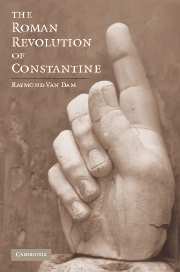Book contents
- Frontmatter
- Contents
- PREFACE
- ABBREVIATIONS
- Map
- Introduction: AUGUSTUS AND CONSTANTINE
- SECTION I A ROMAN EMPIRE WITHOUT ROME
- SECTION II A GREEK ROMAN EMPIRE
- SECTION III EMPEROR AND GOD
- Epilogue: ONE EMPEROR
- APPENDIX 1 HISPELLUM: DATE, TEXT, AND TRANSLATION
- APPENDIX 2 ORCISTUS: DATES, TEXT, AND TRANSLATION
- EDITIONS AND TRANSLATIONS
- BIBLIOGRAPHY
- INDEX
Introduction: AUGUSTUS AND CONSTANTINE
Published online by Cambridge University Press: 05 June 2012
- Frontmatter
- Contents
- PREFACE
- ABBREVIATIONS
- Map
- Introduction: AUGUSTUS AND CONSTANTINE
- SECTION I A ROMAN EMPIRE WITHOUT ROME
- SECTION II A GREEK ROMAN EMPIRE
- SECTION III EMPEROR AND GOD
- Epilogue: ONE EMPEROR
- APPENDIX 1 HISPELLUM: DATE, TEXT, AND TRANSLATION
- APPENDIX 2 ORCISTUS: DATES, TEXT, AND TRANSLATION
- EDITIONS AND TRANSLATIONS
- BIBLIOGRAPHY
- INDEX
Summary
Julian was one of the few roman emperors who had carefully studied Roman history. During the summer of 362 he arrived at Antioch to prepare for an invasion of the Persian empire. In December the city's residents enjoyed the Saturnalia, a lively festival celebrated with games, gambling, and an inversion of social standing as masters and slaves temporarily exchanged roles. Such a raucous festival might have reminded Julian that his own career had been a bit “Saturnalian” in its unforeseen trajectory. As a young man he had avidly studied classical culture, presumably with the hope of becoming a sophist or a philosopher. Instead, and quite unexpectedly, the bookworm had become an emperor. But now, rather than contemplating his own wry twist of fate, Julian decided to evaluate and rank his predecessors on the imperial throne. In the midst of a festival that celebrated role reversal the emperor returned to his original scholarly vocation by writing history.
One of those predecessors was Constantine. Julian's recollections of his uncle were scarred by a painfully personal resentment. After Constantine's death in May 337 troops had murdered several of his relatives, including a half-brother who was Julian's father. One tradition claimed that Constantine himself had already ordered these executions after discovering a plot; Julian would eventually blame Constantius, one of the three sons of Constantine who had succeeded as emperors. Still only a little boy, Julian had been spared and allowed to grow up under the implacable supervision of his cousin Constantius.
- Type
- Chapter
- Information
- The Roman Revolution of Constantine , pp. 1 - 18Publisher: Cambridge University PressPrint publication year: 2007

